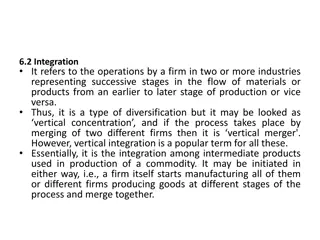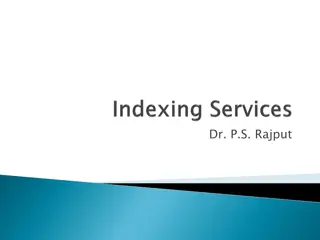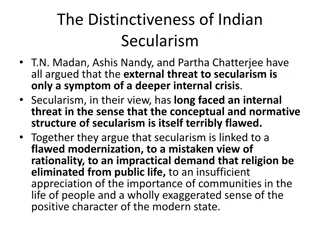Access to Finance: A Case Study of Indian Firms
This case study explores access to finance for Indian firms, focusing on factors such as capital constraints, strategic activities, audit services, and the impact of independent and female directors on finance. It delves into the unique context of India's corporate governance landscape and the influence of limited attention theory on financial decisions.
Download Presentation

Please find below an Image/Link to download the presentation.
The content on the website is provided AS IS for your information and personal use only. It may not be sold, licensed, or shared on other websites without obtaining consent from the author. Download presentation by click this link. If you encounter any issues during the download, it is possible that the publisher has removed the file from their server.
E N D
Presentation Transcript
Access to Finance: A case study of Access to Finance: A case study of Indian firms Indian firms Rasheed Alrashidi Thankom Arun Diogenis Baboukardos
The story.. Needs of finance. (Demirg -Kunt & Maksimovic, 1998; Rajan & Zingales, 1998) Capital constraints . (Lamont et al., 2003). Strategic activities (Hubbard, 1998; Campello et al., 2010), R&D (Himmelberg & Petersen, 1994; Hall & Lerner, 2010). Access to finance as capital constraints. (Cheng et al., 2014).
Previous studies Dhaliwal et al, 2008 and Gul and Goodwin (2010) show the influence of audit services on finance. Anderson et al., 2004; Beasley, 1996; Francis et al., 2012 investigate the effect of independent directors effect the cost of finance. Female directors has impact on the debt (Arun et al., 2015) . However, little empirical research access to finance in these developing countries (Beck et al., 2006; Lorca et al., 2011)
Interest on Developing markets Audit quality Developing markets Developing markets Access to finance as capital constraints Independency board Gender diversity on board Developing markets
India as context of investigation It is an interesting empirical setting. there are concerns regarding the quality of audit services offered even by the large Big-4 accounting firms (Joshy et al., 2015). Low corporate governance, weak investor protection and fastest growing economies. (Narayanaswamy et al., 2012). High female employees, not break glassceiling (Ghosh, 2017). Introduce the Companies Act 2013.
Theory Limited attention theory limited size of attention (Miller, 1956). For instance, selecting process of firms stocks (Barber & Odean, 2008). Performance, size or gender mix might influence finance decisions; as attention grabber. Auditing enhances the reliability, credibility and overall quality of accounting information (Alzoubi, 2018). independent members in developing context might be not independent. (Arora & Sharma, 2016; Lorca et al., 2011; Claessens & Burcin Yurtoglu, 2013) Female director and monitoring (Adams & Ferreira, 2009); reduce ER (Arun et al., 2015).
Aim, R.Q and Hypotheses Aim: To reveal capital providers attitude toward (audit and non-audit fees, independent director and gender of director on board) for listed Indian companies. Research question: To what extend (audit and non-audit fees, independent director and gender of director on board) affect capitalconstrains access to finance in listed Indian firms? H1: There is a positive relationship between audit fees and access to finance for listed firms in India. H2: There is a positive relationship between non-audit fees and access to finance for listed firms in India.
Aim, R.Q and Hypotheses H4: There is a negative relationship between percentage of independent director on board and access to finance for listed firms in India. H3: There is a positive relationship between independent director remuneration and access to finance for listed firms in India. H5: There is a positive relationship between number of female director on board and access to finance for listed firms in India. H6: There is a positive relationship between female directors participates in board committees and access to finance for listed firms in India.
Methodology borrowing The KZ index was developed by (Kaplan & Zingales, 1997; Lamont et al., 2001; Almeida et al., 2003; Baker et al., 2004; Bakke et al., 2010; Zou et al., 2012). KZit= -1.002 CFit/Ai(t_1) -39.368 DIVit/Ai(t_1) - 1.315 Cit/A(it_1) + 3.139LEVi(t) + 0.283Qi(t). dividends over lagged assets; Cit/A(it_1) is cash balances over lagged assets; LEVi(t) is leverage; and Q is the market value of equity (price times shares outstanding) plus assets minus the book value of equity all over assets. Where, CFit/Ai(t_1) is cash flow over lagged assets; DIVit/Ai(t_1) is cash
Methodology borrowing WW-index, it was developed by Whited and Wu (2006) and provides an indication of a company s capital constraints (Li, 2011; Chen & Wang, 2012; Hann et al., 2013; Bodnaruk et al., 2015; Chen et al., 2017). WW index = ( 0.091 CF) (0.062 DIVPOS) + (0.021 TLTD) (0.044 LNTA) + (0.102 ISG) (0.035 SG), indicator that takes the value of 1 if the firm pays cash dividends; TLTD is the ratio of the long-term debt to total assets; LNTA is the natural log of total assets; ISG is the firm s three-digit industry sales growth; and SG is firm sales growth. Where CF is the ratio of cash flow to total assets; DIVPOS is an
Methodology KZit= 0+ 1In AFit 1+ 2Firm sizeit 1+ 3Industryit+ 4Yearit+ it KZit= 0+ 1In NAFit 1+ 2Firm sizeit 1+ 3Industryit+ 4Yearit+ it KZit= 0+ 1INDit 1+ 2Firm sizeit 1+ 3Industryit+ 4Yearit+ it KZit= 0+ 1IND_Rit 1+ 2Firm sizeit 1+ 3Industryit+ 4Yearit+ it (2) WWit= 0+ 1Fit 1+ 2Industryit+ 3Yearit+ it WWit= 0+ 1F_INVit 1+ 2Industryit+ 3Yearit+ it First paper (1) (2) Second paper (1) Third paper (1) (2)
Results First paper H1 Audit fees Capital constraints -0.211*** H2 Non-Audit fees Capital constraints -0.182*** Second paper H3 Percentage of independent director on board Capital constraints 0.749*** H4 Independent director remuneration Capital constraints -0.218*** Third paper H5 Number of female director on board Capital constraints -0.018*** H6 Female directors participates in board committees Capital constraints -0.049***
Conclusion Capital providers believe on the (audit and non-audit fees, and gender of director on board) role in monitoring the management which impact the credibility of financial statements. However, according to the limited attention theory, the independent director on board rising red flag, but their rumination positively grab their attention due to it related to the firms profitability. We believe that our investigation highlights significant insights into the companies by examining the attitude of capital providers toward receiving (audit and non-audit fees, independent director and gender of director on board) in emerging market. By focusing in India context which is unique institutional sitting.
Contribution We extend the access to finance literature by reveal the attitude for the capital providers toward receiving information regarding (audit and non- audit fees, independent director and gender of director on board) in emerging market. Also, this research is among the first to apply a limited attention perspective when explaining the relation between (audit and non-audit fees, independent director and gender of director on board) as attention grabber for capital providers. As such, that would help to improve the availability of credit in future, regulators and Academics.

















































